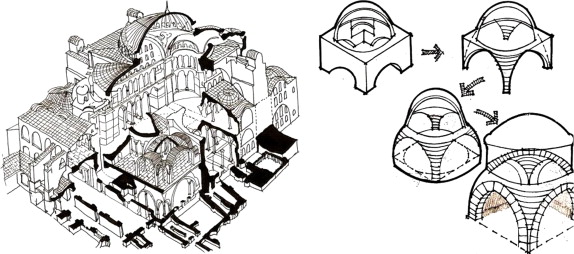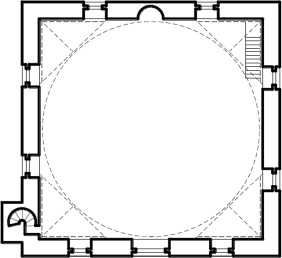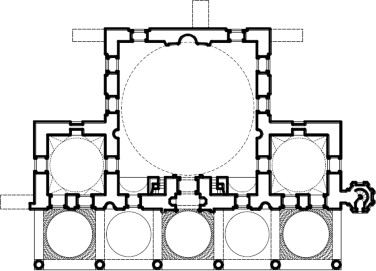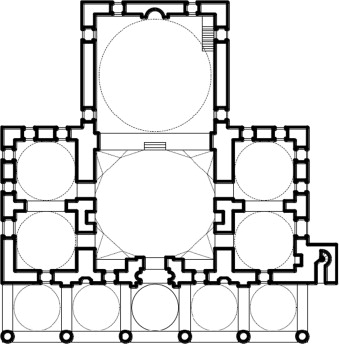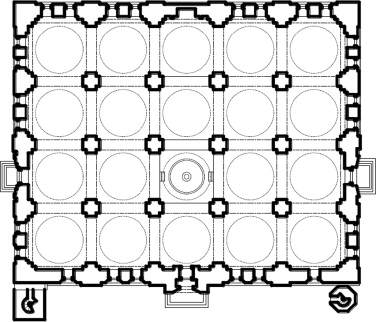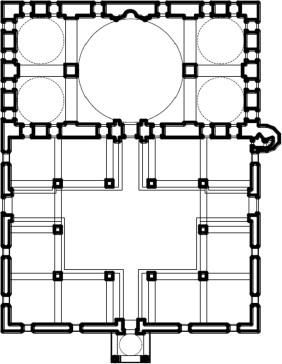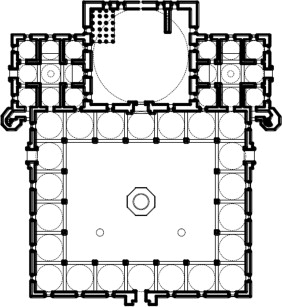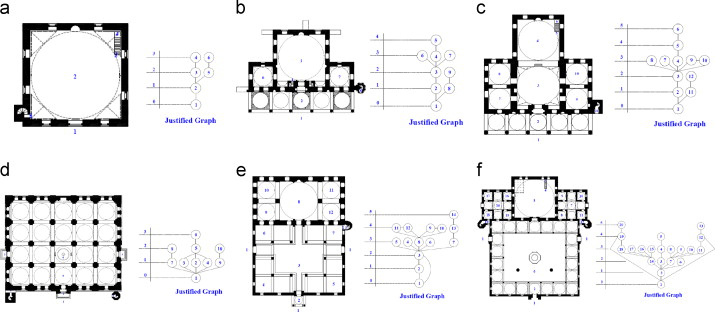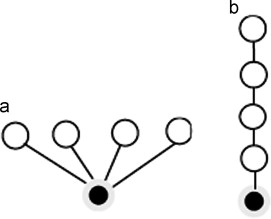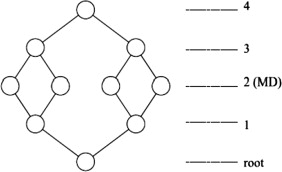Abstract
This study attempts to quantify the influence of spatial configuration on the functional efficiency of mosque layouts in the early Ottoman period. The literature review consists of two parts. The first part is a theoretical study of the relationship between spatial configuration and functional efficiency of mosque layouts. This part highlights the key syntactical characteristics and effect of spatial configuration on the level of functional efficiency using space syntax theory. The second part is an analytical comparative description of the changes and transformations in the configurations of mosque layouts. The architectural styles are classified into six types based on layout designs. The main benchmarks and indicators involved in measuring the functional efficiency of mosque layouts are analyzed using the A-graph 2009 software program, which provides numerical results. This analysis compares entire samples of mosque layout designs for each category. The numerical results indicate the effect of spatial configurations and the functions of mosque layouts. This study shows that mosques with courtyard layouts are accessible, efficient, and flexible in terms of function because of their distinct syntactical and morphological spatial structures.
Keywords
Mosque layout ; Pendentive dome ; Space syntax ; Gamma analysis ; Spatial configuration ; Functional efficiency
1. Introduction
The expansion of territories by the Ottoman Empire resulted in the development of the Ottoman architecture. The Ottomans constructed several public buildings and edifices in various sizes and forms because of the growing needs of the changing Ottoman community (i.e., from an immigrant tribe to an empire). The annexation of new lands to territories that were ruled by the Ottomans enabled Ottoman architects to promote and enhance their construction techniques by working with architects from newly acquired regions. This practice satisfied the increasing demands of a flourishing community. According to the Ottoman regulation, settlers should be accommodated in newly occupied regions. With regard to building architecture, this regulation influenced the construction of several new mosques because the Ottomans practiced Islam. The size and form of the mosques were influenced by a number of factors, such as the Muslim population in a region. The increase in Muslim population required the construction of Jami Mosques, which are known as Cami in the Turkish language. Believers congregate in these mosques every Friday ( Crane, 1993 ; Pasic, 2004 ). A thriving economy can also be another factor in the construction of large mosques because an increase in wealth increases the status of a town. The Ottomans were also conscious of the ability of architecture to immortalize power and wealth. They constructed public buildings with luxurious architectures because mosques had always been an important component of such buildings. The luxurious interiors of these buildings are shown by fenestrations spreading over the façades and shaft of the dome. These fenestrations reflect the grandeur exterior of the building, attract the attention of passersby, and kindle the virtuosity of esthetes. This construction method can be attributed to the Ottomans (Saoud, 2004 ).
This construction method is a blend of indigenous architecture that was inherited by Ottoman culture. It includes the combination of original Ottoman architecture and Islamic regulations called Shariah. Issues such as climate and material concerns in recognized architecture were settled by the indigenous architecture of the area. The indigenous architecture was used by the Ottomans as the foundation in integrating Ottoman culture, bylaws, and religious stances in indigenous culture. The adoption and transformation process defined the architectural generation between the 13th and 15th centuries and resulted in the formation of buildings known today as early Ottoman architecture.
The Ottomans gradually disseminated this architectural tenet during their territorial expansion from Asia Minor to Europe, where Ottoman prints could be easily seen, particularly in the Balkans (C. Flon et al ., 1984 ; Pasic, 2004 ; Saoud, 2004 ). Pendentive dome construction was applied in designing mosques in this region. A pendentive dome refers to the construction of a “dome above a dome,” that is, a dome that seems to be “hanging in the air” over four giant arched supports. The uniqueness of this type of dome construction enables the creation of a large multivolume space in the mosque interior (Mango, 1976 ; Figure 1 ).
|
|
|
Figure 1. Pendentive dome construction: Hagia Sophia (left); types of pendentive dome construction (right). |
The functional efficiency of mosque layouts in the early Ottoman period was affected by the process of spatial configuration over time. This paper applies space syntax theory on the architecture of pendentive dome mosques in the Balkans with respect to the layout design. The mosque is an embodiment of spatial and temporal Islamic laws that directly come from the Quran and Sunnah of the Prophet Muhammad. The primary spatial laws indicate the orientation of the mosque to the Kaabah in Makah and the arrangement of the worshipers in parallel rows behind the imam facing the Qiblah wall. Temporal laws dictate the five ritual performances that are to be performed during specific times of the day according to the movement of the sun. These spatial and temporal laws are uniform throughout the Islamic world regardless of cultural and traditional variations. However, the rules or codes of practice are subject to various interpretations of Islamic schools of thought and Muslim scholars. Such rules may evolve into various traditions influenced by regional cultures.
Nonetheless, the core traditions indicated by the Quran and the Sunnah are intact. To understand the mosque as a building type, formal analysis of the mosque as a constituent of physical/symbolic architectural elements or as an object of events and social process is insufficient. Given the theoretical and methodological tools of space syntax, analysis should focus on the genotype of mosques, that is, configurational regularities that show spatial categories and social practices (Aazam, 2005 ; Aazam, 2007 ). This analysis compares six categories and samples of pendentive dome mosque layouts. Each mosque category was established during different periods and evolved from previous categories (Kuran, 1968 ; Unsal, 1973 ; Mango, 1976 ; C. Flon et al ., 1984 ; Bernardini, 1987 ; Marshall and Rossman, 1999 ; Goodwin, 1993 ; Goodwin, 2003 ; Pasic and Siravo, 2004 ; Guba and Lincoln, 2005 ; Gulru, 2005 ; Omer, 2008 ). These categories are presented as follows.
1.1. Single dome layout (nuclear dome layout)
The single dome layout is the origin and most basic type of pendentive dome mosque. Subsequent developments of the mosque layout design were derived from this category. The Orhan Gazi Mosque in Gebze, Turkey, is a good example of this layout (Figure 2 ). This category has the simplest form among all categories; that is, this layout adopts a square as the main hall and a surmounting dome as the roof. The main hall can be oblong or nearly square. If the planned layout is nearly rectangular, other roofing methods, such as a semi-dome or flat roof, can be used. The presence of a porch on the entrance side of the mosque is a possible variety of this type. The dome of the single dome layout is located at the center of the prayer hall and is called a nuclear dome, which is the most distinct characteristic of this type of mosque layout. This mosque layout gives the impression that the mosque is dominated by the dome. The dome is surmounted on walls by squelches or rectangular structures. Semi-domes in couple form or roofing methods such as a flat roof surrounding the single dome are other methods of covering the prayer hall.
|
|
|
Figure 2. Single dome layout (nuclear dome layout); Orhan Gazi Mosque. |
1.2. Earring layout (pendentive layout)
The earring layout is the second mosque layout category designed during the early Ottoman period. The design of this layout was derived from the single dome layout. The name of this category (pendentive) is borrowed from the pendent shape of the layout plan. The Hatuniye Mosque in Tokat, Turkey, (Figure 3 ) is a good example of this category. The mosque layout was developed from the single dome layout (nuclear layout) by adding smaller spaces to each side of the main hall. From the perspective of the layout plan, these spaces appear like pendents; thus, the shape of the layout is not a pure Platos, form but rather a compound thereof. The layout may have a porch on the entrance side. The entire porch is attached to the building, thus making the square shape of the interior appear rectangular. A series of columns is placed in the absence of a porch.
|
|
|
Figure 3. Earring layout (pendentive layout); Hatuniye Mosque. |
In this category, the number of domes can vary from one to three. A large dome, which is the dominant one, surmounts the prayer hall. The remaining spaces can be covered by smaller domes, although the pendent areas are not always covered with domes. A semi-dome can be applied when the prayer hall is elongated. The semi-dome is usually used once on the prayer hall and is placed on the opposite side of the porch.
1.3. Multiple dome layout
The third category is a double dome layout design. This category is a combination of the single dome and earring layout designs with additional primary and secondary domes. An example of this category is the Murat Pasa Mosque (Figure 4 ) in Istanbul, Turkey. Although this category is a development of the pendentive layout, the general forms of both layouts are similar. In the multiple dome layout, the prayer hall or all three covered spaces (i.e., the prayer hall and both pendent areas) are rectangular. A porch is often used in this category, and a row of columns can be used in the absence of a porch. The pendent areas of most mosques have deep inner spaces. Therefore, the crown part of the main hall is the only part of the layout that exceeds the single pendentive. As the name of this category suggests, this layout consists of several domes. The prayer hall or pendentive areas can have multiple domes, with the number of domes doubled in some cases. The pendentive dome is widely used on grounds that cover rectangular spaces by increasing the number of domes. Similar to other categories, semi-domes and roofing methods can be applied to this category.
|
|
|
Figure 4. Multiple dome layout; Murat Pasa Mosque. |
1.4. Duplication dome layout (rectangular layout)
The fourth category is the duplication dome layout design, which is a development of the multiple dome layout design. The Ulu Cami Mosque in Bursa, Turkey, (Figure 5 ) is representative of the characteristics of this category. The form of the layout in this category is rectangular in both the horizontal axis and the transverse axis. This form is similar to the Islamic architecture of mosques in other regions. The entire layout is divided into spaces by columns or walls. A porch can also be observed in a few cases. The main characteristic of this category is the perfect rectangular form of its layout. More than one dome can be found in this category, and finding the dominant dome is difficult but not impossible. The spans yielded by the columns and walls used to support the vast area of the roof are surmounted by domes. The domes are arranged in rows and columns in proportion to the dimensions of the plan. Aside from other roofing methods, two semi-domes also flank the dome(s) of the prayer hall.
|
|
|
Figure 5. Duplication dome layout (rectangular layout); Ulu Cami Mosque. |
1.5. Courtyard dome layout
The courtyard layout design is the fifth category of the pendentive dome mosque. A good example of this category is the Guzelce Hassan Bey Mosque in Hayrabolu, Turkey (Figure 6 ). The layout of this category is characterized by the rectangular layout, which enables for a square-shaped interior. The remarkable characteristic of this category is the addition of a discernible courtyard to the rectangular layout. Therefore, any mosque characterized by a rectangular layout and a courtyard belongs to this category. Similar to the rectangular layout, semi-domes and other methods of roofing can also be applied to this category. Semi-domes that come in pairs are used to surround the main dome. The main dome is also pendentive, and the surrounding domes cover the corners not covered by the main dome or semi-domes.
|
|
|
Figure 6. Courtyard dome layout; Guzelce Hassan Bey Mosque. |
1.6. Earring dome courtyard layout
The earring courtyard layout design is the sixth category under the pendentive dome mosque. This design is the most complex pendentive dome layout design during the early period of Ottoman architecture. The design is characterized by the earrings, multiple domes, and courtyard layout designs. A good example of this category is the Sultan Bayezid Mosque in Edirne, Turkey (Figure 7 ). The layout of this category integrates the multiple dome layout with the courtyard layout. The interior layout is similar to the interior layout of the multiple dome layout with an added courtyard, which comes from the courtyard layout. The courtyard has four riwaqs (i.e., an element in traditional buildings in the form of corridors or galleries) along the walls and a pond at the center. The dome in this category resembles the dome of the multiple dome layout. The roof of the prayer hall can be singular and dominant or can be surrounded by semi-domes and smaller domes. The pendentive areas are surmounted by an array of domes similar to those in the rectangular layout with all possible varieties.
|
|
|
Figure 7. Earring dome courtyard layout; Sultan Bayezid Mosque. |
2. Space syntax and mosque layouts
Space syntax is a theory of space and contains a set of analytical, quantitative, and descriptive tools that can be used to analyze the spatial formations of building layouts, cities, and landscapes (Hillier and Hanson, 1988 ; Hillier, 2007 ). Space syntax reveals the relationship between human beings and their inhabited spaces. The distinctive characteristics of societies exist within spatial systems and are conveyed through space and the organization of spaces (Osman and Suliman, 1993 ; Dursun and Saglamer, 2003 ). Space syntax refers to this relational characteristic of space as a configuration; this characteristic forms human behavior and contains social knowledge (Aazam, 2007 ; Dursun, 2007 ).
Space syntax research aims to develop strategies for describing the configurations of occupied/inhabited spaces to articulate underlying social meanings. This process enables the development of secondary theories or practical explanations on the effects of spatial configuration on various social or cultural variables. A related theme in space syntax research is the comprehension of configured/functioned space itself, particularly the formative process and social meaning of space (Bafna, 2003 ). Space syntax attempts to formulate a configurational theory in architecture by generating a theoretical understanding of how people create and use spatial configurations (e.g., mosque layouts). Therefore, space syntax attempts to identify how spatial configurations express a social or cultural meaning and how spatial configurations generate the social interactions in built environments. A considerable number of research and publications have shown that previous space syntax studies focus on real environments and identify the intrinsic nature of man-made environments.
By developing consistent techniques to represent and analyze spatial patterns, recent space syntax studies have attempted to simulate spatial designs in mosque layout proposals and predict how these designs will work (Hillier et al ., 1983 ; Hillier et al ., 1984 ; Hillier et al ., 1987a ; Hillier et al ., 1987b ; Hillier et al ., 1987c ; Steadman, 1983 ; Hillier and Hanson, 1988 ; Peponis and Wineman, 2002 ; Ratti, 2004 ; Hillier and Tzortzi, 2006 ; Hillier, 2007 ). Space syntax research and application have demonstrated that the spatial arrangements in any building layout (e.g., mosque layouts) have a discernible and measurable influence on human (worshiper) behavior. Considering that these effects can be modeled, predicted, and improved prior to construction, designers must understand the relationship between layout design and human behavior (Bafna, 2003 ; Aazam, 2007 ).
3. Functional efficiency of mosque layouts
One of the most important approaches that epitomize the distinct traits of society is the manner by which space is organized for human purposes; this approach achieves the appropriate and efficient functions of building layouts (Aspinall, 1993 ; Voordt et al ., 1997 ). A product or process is considered functional when the product or process used is suitable for its purpose. For buildings, functionality may be defined as the degree to which activities are supported by the built environment. Functionality is related to the amount and form of space, the spatial relationship between spaces (functional zoning), and the routing through the building for the distribution of people (Voordt et al., 1997 ). In architectural design, function is approached mainly as a sequence of human actions coupled with equipment to satisfy specific practical requirements on a daily basis inside a given spatial unit (Reverson, 2009 ). Hillier (2007) defines functionality “as the ability of a complex to accommodate functions in general and therefore potentially a range of different functions , rather than any specific function .” Functional factors, such as the relationships between spaces and activities, appropriate axes of movement, flexibility, suitability, and safety, are the key aspects of a building layout design. These factors are closely related to the activities and organizational performances of the occupants. Functional considerations play an important role in the success of a building; thus, incorrect configuration will result in inefficient and unacceptable functions ( Al-Nijaidi, 1985 ; Karlen, 2009 ). Therefore, functionality is the overall viability of a building in accommodating functions (e.g., multifunctionality and diversity) and achieving a range of different functions rather than a specific function ( Bustard, 1999 ; Hanson, 2003 ).
A built space is considered efficient when everyday users, worshippers, and visitors can participate in various activities without experiencing difficulties. The spatial–functional features that are relevant to efficiency include the spatial clustering of functionally related activities, short distances (spatial depth), and prevention of physical barriers between frequently used spaces in mosque layouts. The degree of efficiency achieved by building layouts can be determined by indicators, such as the availability of interior spaces for individual and communal use and the openness or closeness of physical partitions. Therefore, the two following components are important:
- Psychological efficiency refers to the extent in which a building “invites” the potential user or visitor to enter by using the appearance of and activities in a building. The relevant spatial aspects include a recognizable entrance; clear transitions and circulation from the public to private sectors; syntactical characteristics that facilitate spatial–functional orientations, such as a clear outline of a building layout, visual axes, points of recognition, and differentiation in the use of spaces.
- Physical efficiency refers to the ease in which users and visitors can reach, enter, and move through a building to use various spaces. A particular focal point is integral accessibility; that is, people with physical disabilities can also enter and move through the building independently. “Access for all” can be determined from the floor plans based on indicators, such as the type of space, degree of integration of each space within the spatial layout, depth of space, manner of distribution of functional spaces into zones, and variety of internal arrangements of spaces in terms of flexibility, freedom, inclusiveness, and other design devices. These indicators provide opportunities to improve the physical efficiency of a building (Hamdi, 1991 ; Voordt et al ., 1997 ; Habraken, 1998 ; Friedman, 2002 ). Spaces are usually connected in ways that modify the distribution of integration throughout a structure, thus causing a number of areas to become more accessible than the rest. This sequence of integration regulates the interactions between users/worshippers and causes spatial–functional relationships to become efficient and flexible (Dawson, 2002 ).
4. Space syntax method for interpreting mosque layouts
The space syntax method is an approach developed to analyze spatial configuration. Space syntax aims to describe spatial models (e.g., mosque layouts) and represent these models in numerical and graphical forms, thus facilitating scientific interpretation (Hanson, 2003 ; Franz et al ., 2005 ; Manum, 2009 ). This method was adopted to deal with the syntactical characteristics of the spatial configuration of mosque layouts because of the following reasons:
- This method combines physical and social indicators in explaining the spatial–functional systems to identify configurations in terms of differences and similarities, thus enabling the diagnosis of the strengths and weaknesses of structures, types, and patterning of mosque layouts.
- This method adopts the syntactical characteristics of spatial configuration (i.e., symmetry–asymmetry and distributedness–non-distributedness) in interpreting the structures of different mosque layouts.
- This method facilitates the analysis, evaluation, and comparison of various systems.
- This method can assess, understand, describe, and model various formal and spatial systems, thus providing sufficient credibility and reality.
4.1. Space syntax analysis of mosque layouts
Space syntax indicates that the organization of architectural space in mosque layouts can result from two key syntactic characteristics, namely, symmetry–asymmetry and distributedness–non-distributedness, which are directly linked to the functionality of the mosque layout.
The symmetry–asymmetry property expresses the kinetic-visual depth of various spaces within the spatial system (i.e., mosque layout) in terms of the main space (i.e., main gate/entrance). If the depth of the space within the mosque layout is lower than the depth of the other spaces in the system, the space is more symmetric and vice versa. Space segregation increases when the number of kinetic-visual steps between the spaces in the mosque layout increases, thus resulting in the weakening of the functional relationship (i.e., efficiency). This phenomenon is caused by the inverse relationship between segregation and functional efficiency. This relationship refers to the degree of symmetry of any space in the spatial system (i.e., mosque layout). Therefore, if any space in the mosque layout moves away from the main space (e.g., the entrance) by one kinetic-visual step, space separation will not occur. However, the link will be direct, and the space will be symmetrical. Increasing the space symmetry decreases the space segregation, resulting in an efficient functional relationship. When the space moves away by more than one kinetic-visual step from the main space, the space will become asymmetrical (Hillier and Hanson, 1988 ; Hillier, 2007 ).
The distributedness–non-distributedness property reflects the available options for accessing all spaces in the system (i.e., mosque layout). By increasing the number of methods of accessing a particular space, the distributedness of a space in a system will increase, suggesting that the kinetic permeability of a space is at a high level with little segregation and vice versa. A non-distributed space has simple permeability, suggesting the existence of one kinetic method to enter another space. Permeability (i.e., distributedness–non-distributedness) reflects the movement of prayer within the spatial system in terms of smoothness, efficiency, and flexibility, and it represents a certain organizational behavior of prayers and its circulation. Therefore, depth-maximizing plans (i.e., mosque layouts) are functionally inflexible and unsuitable for most types of functional patterns compared with depth-minimizing plans, which enable the efficient function of a mosque (Peponis, 1985 ; Hillier, 2007 ).
4.2. Space syntax indicators and measurements
The syntactical characteristics of spatial interior configurations (i.e., symmetry–asymmetry and distributedness–non-distributedness), which affect the functional efficiency of the mosque layout, can be measured by numerical values using the following benchmarks and indicators.
4.2.1. Indicator of degree of integration (real relative asymmetry)
The degree of integration of a space is an indicator related to the property of symmetry–asymmetry. This indicator reflects the relative depth of space in relation to the rest of the spaces in any spatial system (Hillier and Hanson, 1988 ). The mean depth of a space (MD) from all other spaces in the configuration (i.e., mosque layout) is the integration (i.e., real relative asymmetry (RRA)) that describes the extent of permeability of that particular space. Low values correspond to high integration, whereas high values correspond to high segregation (Manum, 2009 ). The integration degree of space can be calculated as follows.
4.2.1.1. Calculating MD
- A justified graph is created by designating the intended space as the key space (i.e., root space) at the base of a mosque layout to measure the relative depth of the intended space. The remaining spaces are then aligned above the root space according to the number of spaces that must be taken to arrive at each space from the root space. Each space in the system is represented by a small circle, and the permeability between spaces is represented by linked lines.
- The depth of each space is calculated in the graph from the root space, where the depth of each space is represented by the number of spaces needed to transition from the root space to any space in the system (Figure 8 ).
|
|
|
Figure 8. Justified permeability graphs (gamma analysis method) of mosque layouts (six case studies/categories). |
The least depth can be achieved when all spaces are directly connected to the original space (i.e., root space), whereas the greatest depth can be obtained when all spaces are arranged in a linear sequence away from the original space. The space is symmetric in the former case with respect to the other spaces in the system, whereas the space is asymmetric in the latter case (Hillier and Hanson, 1988 ; Hillier, 2007 ) (Figure 9 ).
|
|
|
Figure 9. Symmetric spatial system (Spaces connect directly to the root space; minimum depth: symmetric system) (a); asymmetric spatial system (Linear sequence of spaces; maximum depth: asymmetric system) (b) (Hillier et al., 1987a ). |
MD can be calculated as follows:
|
|
( 1) |
where M.D is the mean depth of space from the root space, ΣD is the total magnitude of depth for all spaces in the system from the root space, and K is the total number of spaces in the graph.
4.2.1.2. Calculating the integration value of space (relative asymmetry)
The relative depth of a space from all other spaces in the graph can be expressed as follows:
|
|
( 2) |
where R.A is the relative asymmetry integration value of space, M.D is the mean depth of space, and K is the total number of spaces in the graph.
Therefore, relative asymmetry (RA) numerically expresses a key aspect of the shape of the justified graph from that space. RA varies between zero and one: zero indicates maximum integration, that is, no depth (high functional efficiency), and one indicates maximum segregation, that is, maximum depth (low functional efficiency) (Hillier et al ., 1987a ; Onder, 2002 ; Toker and Toker, 2003 ; Zako, 2006 ). The measurements of integration and depth are obtained using the exterior space (of the mosque) as the root space in relation to the rest of the spaces in the spatial system (i.e., mosque layout). The depth from the root is considered the number of steps that separate a determined space from the front door/main entrance. Describing the sequence of activities from the mosque entrance is of particular interest because this sequence describes the primary experience in buildings, that is, movement from the entrance to any specific place in the structure. Therefore, RA is a useful measurement for understanding front and back notions as well as the relationship between spaces that are open to worshippers and spaces that are specifically for prayers.
4.2.1.3. Calculating the RRA
The RA value resulting from Eq. (2) must be adjusted to facilitate the numerical comparison between spaces of different systems. The RA value for each space in the system is adjusted with its value in the depth graph with a diamond-shaped or pyramid-shaped pattern ( Hillier et al ., 1987a ; Hillier and Hanson, 1988 ; Asami et al ., 2003 ) (Figure 10 ).
|
|
|
Figure 10. Diamond-shaped graph used to calculate the integration of spaces (Hillier et al ., 1987a ; Hillier and Hanson, 1988 ; Asami et al ., 2003 ). |
The depth of the diamond-shaped graph represents an intermediate situation between the maximum mean depth of space when the spaces are organized in a linear sequence with respect to the root space (as previously mentioned) and the least mean of depth when all spaces are linked directly to the root space (Hillier and Hanson, 1988 ). Therefore, RRA can be calculated as follows:
|
|
( 3) |
where R.R.A is the real relative asymmetry of space, R.A is the relative asymmetry of space, and DK is the RA of space from a diamond-shaped graph.
RRA is a sensitive measure of building layouts. This value varies around the number one; values less than one correspond to the most integrated and least segregated spaces in the system, whereas values greater than one correspond to the most segregated spaces. The relations between functional activities are expressed in space through the spatial relationships between the spaces of a mosque under the assumption that the properties of integration and segregation indicate space efficiency ( Hillier et al ., 1987a ; Zako, 2006 ) and the type of functional use of spaces occupied by prayers.
4.2.2. Difference factor of space (H *)
Integration values indicate the permeability of a configuration in quantitative terms. Extensive research demonstrates that integration values are highly predictive of the use of space. The degree of variance in integration values is considered an indication of the strength or weakness of social relations with respect to spatial ordering, that is, the amount of interchangeable space. The difference factor is used to quantify this difference as a proportion of the sum of integration values of spaces under consideration (Guney, 2005 ; Bellal, 2007 ). In most spatial complexes, different functions and activities are assigned to specific spaces, thus integrating complexes to different degrees (i.e., numerical values). If the integration values of these spaces are consistent across a sample, a cultural pattern is assumed to be expressing itself spatially. This particular type of consistency in spatial patterning is called “inequality genotypes.” The strength or weakness of the inequality between integration values expresses the degree of cultural importance placed on the integration or segregation (Hillier et al ., 1987a ; Al-Jaff, 1989 ; Hanson, 2003 ). An entropy-based measure called a difference factor is used to quantify the degree of difference between the integration values of any three spaces (or more with a modified formula) or functional activities. This measure is an adaptation of Shannons H -measure for transition probabilities, in which the integration values of the spaces are substituted for transition probabilities ( Zako, 2006 ):
|
|
( 4) |
where H is the unrelativized difference factor for the three spaces; a , b , and c are the integration values of any three spaces in the configuration (mosque layout); and t is the sum of the three spaces, that is, t =Σ(a+b+c ).
Eq. (4) describes the variance in the integration within each spatial structure. This variance may be a result of the functional differentiation in the use of space (Bustard, 1999 ). H can be relativized between Ln2 and Ln3 to obtain the relative difference factor (H *), which varies between zero and one. H *=0 corresponds to the maximum difference, that is, strong functional differentiation, which refers to the real functional efficiency of the space. H *=1 corresponds to the minimum or no difference (i.e., no functional differentiation), indicating that no real difference exists in the values of integration and that no real functional efficiency exists for the space ( Hillier et al., 1987a ). Therefore, H * can be calculated according to the following modified formula:
|
|
( 5) |
A low H * value indicates the existence of a “strong” genotype. By contrast, values close to one indicate the existence of “weak” genotypes, suggesting that no functional differentiation and weakness exist in the functional efficiency of a space. These simple measures, as clarified by Zako (2006) , can express culturally significant typological differences among various mosque layouts over time, as such measures are based on concepts founded on intrinsic social logic.
4.2.3. Indicator of the spatial system (space–link ratio)
Integration was proposed as a syntactical measure to assess the symmetry–asymmetry properties of a spatial system, and the relative “ringiness” measure was proposed to assess the distributedness–non-distributedness properties. Distributedness represents the existence of more than one non-intersecting route from a given point in a system to another point. If only one route exists for any two points in the system, the system is considered a non-distributed system with a tree-like structure (Figure 11 a). In a tree-like structure, p -1 lines connect the structure together, where p is the number of nodes in the spatial system ( Guney, 2005 ; Bellal, 2007 ). Any increase in the number of lines in the system will indicate the existence of rings in the system; that is, the system has a ringy structure (Figure 11 b). This indicator is used to measure the distributedness–non-distributedness property of each space and the entire spatial system (i.e., mosque layout). Measuring the degree of “ringiness” of a spatial system, that is, the space–link ratio R , represents the extent of permeability of the spatial system. The space–link ratio is the ratio of the number of links located between the spaces plus one to the number of spaces in a spatial system of a mosque.
|
|
|
Figure 11. Tree-like structure (a); ringy structure (b). |
The R values vary around the number one, with the values greater than one corresponding to a high degree of “ringiness” and distributedness of a spatial system (i.e., ringy structure). This distributedness indicates a high degree of flexibility (i.e., functional efficiency) in using the space, enabling the user (i.e., prayer) to change the layout to adapt to different circumstances by closing or opening doors. A value less than one indicates that the spatial system has a tree-like structure, suggesting the lack of distributedness and the increase in the depth of spaces within the mosque layout ( Guney, 2005 ; Bellal, 2007 ). R can be calculated as follows:
|
|
( 6) |
where R is the space–link ratio of spaces in a spatial system (i.e., mosque layout), L is the number of lines of the link between spaces in the justified graph, and K is the number of spaces in the system.
4.2.4. Indicator of space type (degree of spaceness)
Aside from the measurements of depth, integration, and ringiness, space syntax also provides a way to categorize the types of space in the system depending on the topological characteristics of the building spaces that satisfy the functional requirements of occupation and movement. According to the space syntax terminology, four different topological types of space exists: a-type space, which has one link; b-type space, which has more than one connection and lies on a tree; c-type space, which has more than one connection and lies on a ring; and d-type space, which has more than two connections and lies on at least two rings. Therefore, a- and b-type spaces indicate tree-like graphs, whereas c- and d-type spaces indicate ringy graphs (Hanson, 2003 ; Manum, 2005 ; Guney, 2005 ; Bellal, 2007 ).
Occupation is assumed suitable for an a-type space, where no “through” circulation exists. Movement is suitable for b-, c-, and d-type spaces, with d-type spaces offering the greatest movement. The degree of spaceness (terminology borrowed from Amorim (1999) ), such as the a-ness or b-ness of spaces, can indicate the extent to which these properties are embedded in the graphs. It offers insights into the terms of space use within the mosque layout.
To calculate the degree of a-ness of a mosque layout, the number of a-type spaces is divided by the total number of spaces minus one, as the maximum number of a-type spaces can be found in a shallow bush graph with all a-type nodes connected to a b-type single node. The degree of b-ness is calculated by dividing the number of b-type spaces in a mosque layout by the total number of spaces minus two, as b-type spaces always have a way of entering another space. The degree of c-ness and d-ness is calculated by dividing the number of c- or d-type spaces by the total number of spaces in the layout (Guney, 2005 ).
5. Results and discussion
The following data are obtained by examining the results of the analyses using the space syntax methodology (specifically the gamma analysis method). The MD value is 2.067 for mosques with single dome layouts, 2.722 for mosques with earring layouts, 2.879 for mosques with multiple dome layouts, 2.356 for mosques with duplication dome layouts, 2.517 for mosques with courtyard dome layouts, and 3.042 for mosques with earring dome courtyard layouts.
The overall spaces in the courtyard dome and earring dome courtyard layouts are more integrated than those in the other remaining layouts. This finding is supported by the high mean value of RRA for the courtyard dome and earring dome courtyard layouts, that is, 0.946 and 1.009, respectively. This finding demonstrates the tendency of the system (i.e., layouts) to be significantly integrated (i.e., more accessible, efficient, and flexible) compared with other cases that have low mean RRA values. Therefore, the spatial configuration of layouts with low mean RRA values tend to be segregated, controlled, and less efficient in terms of function. The justified graphs (i.e., gamma maps) reveal that 33.33% of mosque layouts have tree-like structures (i.e., having a small number of rings within their configurations).
The mean R value of the layouts with tree-like structures is 1.000, suggesting that these mosque layouts are generally non-distributed. For the other mosque layouts (66.66%) with “ringy” structures, the mean value of R is greater than 1.000, indicating that these layouts are spatially and functionally distributed structures (i.e., having more rings within their configurations) (Table 1 ).
| Mosque layout pattern | Mean (MD ) | Mean (RRA ) | Space–link ratio (R ) |
|---|---|---|---|
| Single dome layout | 2.067 | 1.528 | 1.000 (tree structures) |
| Earring layout | 2.722 | 1.552 | 1.000 (tree structures) |
| Multiple dome layout | 2.879 | 1.318 | 1.167 (ringy structures) |
| Duplication dome layout | 2.356 | 1.108 | 1.200 (ringy structures) |
| Courtyard dome layout | 2.517 | 0.946 | 1.214 (ringy structures) |
| Earring dome courtyard layout | 3.042 | 1.009 | 1.050 (ringy structures) |
The values of H * for all cases can be obtained from the values of RRA in Table 1 . These values are presented as follows.
H * is 0.685 for mosques with single dome layouts, 0.744 for mosques with earring layouts, 0.658 for mosques with multiple dome layouts, 0.702 for mosques with duplication dome layouts, 0.562 for mosques with courtyard dome layouts, and 0.695 for mosques with earring dome courtyard layouts. These findings indicate that mosques with courtyard dome layouts have the lowest difference factor value among all types of mosque layouts (Table 2 ).
| Mosque layout pattern | Mean integration | Max. integration | Min. integration | Difference factor (H *) |
|---|---|---|---|---|
| Single dome layout | 1.528 | 2.292 | 0.573 | 0.685 |
| Earring layout | 1.552 | 2.591 | 0.789 | 0.744 |
| Multiple dome layout | 1.318 | 2.36 | 0.574 | 0.658 |
| Duplication dome layout | 1.108 | 1.725 | 0.454 | 0.702 |
| Courtyard dome layout | 0.946 | 1.777 | 0.336 | 0.562 |
| Earring dome courtyard layout | 1.009 | 1.689 | 0.442 | 0.695 |
With regard to space type (i.e., spaceness), Table 3 shows the mean values for the four types of spaces (i.e., a, b, c, and d) in mosque layouts and patterns adopted in the analysis to facilitate comparison. The adopted approach reveals that mosques with courtyard dome layouts are the most important because the values of the c- and d-types of spaces are the highest, whereas the values of the a- and b-types of spaces are the lowest.
| Space-type | |||||
|---|---|---|---|---|---|
| Mosque layout pattern | Mean (a-ness) | Mean(b-ness) | Mean (c-ness) | Mean (d-ness) | |
| Single dome layout | 0.600 | 0.750 | 0.00 | 0.000 | |
| Earring layout | 0.625 | 0.571 | 0.00 | 0.000 | |
| Multiple dome layout | 0.273 | 0.400 | 0.333 | 0.083 | |
| Duplication dome layout | 0.333 | 0.250 | 0.300 | 0.200 | |
| Courtyard dome layout | 0.308 | 0.167 | 0.500 | 0.071 | |
| Earring dome courtyard layout | 0.526 | 0.111 | 0.300 | 0.100 | |
6. Conclusions
Descriptive analysis reveals that the pendentive dome is an important element in the layout design of the Ottoman mosque architecture during the 13th to 15th centuries. The pendentive dome refers to the construction of a dome above the construction system of a dome, creating vast interiors and multiple volume spaces. However, design emphasis is focused not on the dome (except in the single dome layout design) but on the number of square plan units to determine the dimension of prayer halls. A higher number of square plan units used in a layout design correspond to larger prayer halls. Although dome size influences the size of the square plan unit, dome size does not play a significant role in specifying the size of the plan layout. Master builders adopted a hierarchical ordering system by integrating primary, secondary, and tertiary (riwaq ) square plan unit modules in the design to specify the dimensions of prayer halls and variations of layouts. The latest design integrates a courtyard that functions as an exterior prayer area with riwaqs at its perimeters. This design concept has led to the development of the pendentive dome mosque architecture in the later Ottoman period. The following conclusions are drawn based on the space syntax analysis:
- Among the mosque layouts, a mosque with a courtyard layout represents the best layout in terms of functional efficiency according to the indicators of spatial depth (MD ) and the degree of integration (RRA ). Therefore, contemporary mosque layout designs must apply this type of layout to achieve the efficient use of space.
- The values of the indicator of difference factor (H⁎ ) reveal that a mosque with a courtyard dome layout has the highest difference, indicating strong distinction and functional differentiation compared with the other types and patterns of mosque layouts. This finding confirms the need to adopt the courtyard dome layout in the contemporary design of mosques, as the difference factor demonstrates the independence of space (e.g., the main hall of prayer or the courtyard) with other spaces. A strong independence corresponds to a high level of functionality and efficiency.
- The R values reveal that a mosque with a courtyard dome layout has high distributedness, indicating the importance (i.e., efficiency) of this type of layout at the spatial–functional level. This high distributedness is due to the presence of a large number of rings in configurations, which provide high accessibility to the system. The space type indicator (i.e., spaceness) is also an effective measure for evaluating mosque layouts. A mosque layout with a courtyard element is significantly efficient according to the syntactical approach (i.e., space syntax). This result is evidenced by the high values of the c- and d-types of spaces (most efficient and flexible) and the low values of the a- and b-types of spaces. This finding indicates the need for the spatial integration of spatial types in the layout of any contemporary design.
- The present study reveals the positive relationship between the process of spatial configuration and the level of functional efficiency according to different types and patterns of mosque layouts by using an analytical comparative approach in evaluating, discussing, and interpreting the resultant data. The indicators largely contributed to quantifying the level of functional efficiency of different mosque layouts. The results clearly show that the efficiency of mosque layouts changes over time because of the spatial configuration of varying layouts.
The results support the research hypothesis that the functional efficiency of mosque layouts is affected by spatial configuration over time. Analysis is performed using space syntax theory to obtain numerical results and to support the hypothesis by indicating the level of efficiency. The combination of descriptive and space syntax methodology promotes the effective evaluation of different types and patterns of mosque layouts. Both of these methodologies complement each other in gaining insight into the syntactical and morphological structure of various mosque layouts and categories.
References
- Al-Jaff, 1989 A.J. Al-Jaff; Communication in Architecture: An Application of Space Syntax; Department of Architecture, University of Technology, Baghdad, Iraq (1989) (M.Sc. Thesis)
- Al-Nijaidi, 1985 H.R. Al-Nijaidi; Flexibility in the Design of Building; Department of Architecture, Oxford Polytechnic, London, UK (1985) (Ph.D. Thesis)
- Amorim, 1999 L. Amorim; The Sectors Paradigm: A Study of the Spatial and Functional Nature of Modernist Housing in Northeast, Brazil; The Bartlett School of Graduate Studies, University College London, London, UK (1999) (Ph.D. Thesis)
- Asami et al., 2003 Asami, Y., Kubat, A.S., Kitagawa, K., Iida, S., 2003. Introducing the third dimension on space syntax: application on the historical Istanbul. In: Proceedings of the 4th International Space Syntax Symposium, London, 48, 1-48.
- Aspinall, 1993 P. Aspinall; Aspects of spatial experience and structure; B. Farmer, H. Louw (Eds.), Companion to Contemporary Architecture Thought, Rutledge, London (1993), pp. 337–345
- Aazam, 2005 Aazam, Z., 2005. The social logic of the mosque: a building and urban spatial investigation. In: Proceedings of the 5th International Space Syntax Symposium, Faculty of Architecture, Technology University, Delft, Netherlands.
- Aazam, 2007 Aazam, Z., 2007. The social logic of the mosque: a study in the relationships between building typology and urban morphology. In: Proceeding of the 6th International Space Syntax Symposium, Istanbul, Turkey, 058, 1–18.
- Bafna, 2003 S. Bafna; Space syntax: a brief introduction to its logic and analytical techniques; Environment and Behavior, 35 (1) (2003), pp. 17–29
- Bellal, 2007 Bellal, T., 2007. Spatial interface between inhabitants and visitors in M'zab houses. In: Proceedings of the 6th International Space Syntax Symposium, Istanbul, Turkey, 061, 1–14.
- Bernardini, 1987 M. Bernardini; The impact of Sinan on Turkish revivalism; A. Petruccioli (Ed.), Environmental Design: The Urban Vision, 1-2, Islamic Environmental Design Research Centre, Istanbul (1987), pp. 216–221
- Bustard, 1999 W. Bustard; Space, evolution, and function in the houses of Chaco canyon; Environment and Planning B: Planning and Design, 26 (2) (1999), pp. 219–240
- Crane, 1993 H. Crane; Notes on Saldjuq architectural patronage in Thirteen century Anatolia; Journal of the Economic and Social History of the Orient, 36 (1) (1993), pp. 1–57
- Dawson, 2002 P.C. Dawson; Space syntax analysis of Central Inuit snow houses; Journal of Anthropological Archaeology, 21 (4) (2002), pp. 464–480
- Dursun, 2007 Dursun, P., 2007. Space syntax in architectural design. In: Proceedings of the 6th International Space Syntax Symposium, Istanbul, Turkey, 056, 1–12.
- Dursun and Saglamer, 2003 Dursun, P., Saglamer, G., 2003. Spatial analysis of different home environments in the city of Trabzon, Turkey. In: Proceedings of the 4th International Space Syntax Symposium, London, 54, 1–18.
- C. Flon et al., 1984 C. Flon The world atlas of architecture (Le Grand Atlas de lâ•ZArchitecture Mondiale) C. Dufton Trans. 1984 Mitchell Beazley International Ltd. London.
- Franz et al., 2005 G. Franz, M. Heyde, H.H. Bülthoff; Predicting experiential qualities of architecture by its spatial properties; B. Martens, A.G. Keul (Eds.), Designing Social Innovation: Planning, Building, Evaluating, Cambridge University Press, Cambridge (2005), pp. 157–166
- Friedman, 2002 A. Friedman; The Adaptable House: Designing Homes for Change; McGraw Hill, New York (2002)
- Goodwin, 1993 G. Goodwin; Sinan Ottoman Architecture and its Values Today; Saqi Books, London (1993)
- Goodwin, 2003 G. Goodwin; A History of Ottoman Architecture; Thames & Hudson Ltd, London (2003)
- Guba and Lincoln, 2005 E.G. Guba, Y.S. Lincoln; Paradigmatic controversies, contradictions, and emerging confluence; N.K. Denzin, Y.S. Lincoln (Eds.), The Sage Handbook of Qualitative Research (3rd ed.), Sage publications Ltd., Thousand Oaks, California (2005), pp. 191–215
- Gulru, 2005 N. Gulru; The age of Sinan: architectural culture in the Ottoman Empire; N. Gulru (Ed.), Muqarnas: An Annual of Visual Culture of the Islamic World, Reaktion Books, London (2005), pp. 141–184
- Guney, 2005 Guney, Y.I., 2005. Spatial types in Ankara apartments. In: Proceedings of the 5th International Space Syntax Symposium, Faculty of Architecture, Technology University, Delft, Netherlands.
- Habraken, 1998 N.J. Habraken; The Structure of the Ordinary: Form and Control of the Built Environment; MIT Press, Cambridge (1998)
- Hamdi, 1991 N. Hamdi; Housing without House; Van Nostrand Reinhold, New York (1991)
- Hanson, 2003 J. Hanson; Decoding Homes and Houses; Cambridge University Press, Cambridge (2003)
- Hillier, 2007 B. Hillier; Space is the Machine: A Configurational Theory of Architecture; Space Syntax Laboratory, London (2007)
- Hillier et al., 1987c B. Hillier, R. Burdett, J. Peponis, A. Penn; Creating life: or, does architecture determine anything?; Architecture and Comportment/Architecture and Behavior, 3 (3) (1987), pp. 233–250
- Hillier et al., 1983 B. Hillier, J. Hanson, J. Peponis, J. Hudson, R. Burdett; Space syntax: a new urban perspective; Architects Journal, 178 (48) (1983), pp. 47–63
- Hillier et al., 1984 B. Hillier, J. Hanson, J. Peponis; What do we mean by building function?; J.A. Powell, I. Cooper, S. Lera (Eds.), Design for Building Utilization, Spon, London (1984), pp. 61–72
- Hillier et al., 1987a B. Hillier, J. Hanson, H. Graham; Ideas are in things: an application of the space syntax methods to discovering house genotypes; Environment and Planning B: Planning and Design, 14 (1) (1987), pp. 363–385
- Hillier et al., 1987b B. Hillier, J. Hanson, J. Peponis; Syntactic analysis of settlements; Architecture and Behavior, 3 (3) (1987), pp. 217–231
- Hillier and Hanson, 1988 B. Hillier, J. Hanson; The Social Logic of Space; Cambridge University Press, Cambridge (1988)
- Hillier and Tzortzi, 2006 B. Hillier, K. Tzortzi; Space syntax: the language of museum space; S. MacDonald (Ed.), A Companion to Museum Studies, Blackwell Publishing, London (2006)
- Karlen, 2009 M. Karlen; Space Planning Basics; (third ed.)John Wiley & Sons, New Jersey (2009)
- Kuran, 1968 A. Kuran; The Mosque in Early Ottoman Architecture; The University of Chicago Press, Chicago and London (1968)
- Mango, 1976 A.C. Mango; Byzantine Architecture; Harry N. Abrams Inc., New York (1976)
- Manum, 2005 Manum, B., 2005. Generality versus specificity: a study on the interior space of apartments. In: Proceedings of the 5th International Space Syntax Symposium, Faculty of Architecture, Technology University, Delft, Netherlands.
- Manum, 2009 Manum, B., 2009. A-graph complementary software for axial-line analysis. In: Proceedings of the 7th International Space Syntax Symposium, Stockholm, Sweden, 070, 1–9.
- Marshall and Rossman, 1999 C. Marshall, G.B. Rossman; Designing Qualitative Research; (third ed.)Sage publications Ltd., Thousand Oaks, California (1999)
- Omer, 2008 S. Omer; The Origins and Functions of Islamic Domestic Courtyards; International Islamic University Malaysia Press, Kuala Lumpur (2008)
- Onder, 2002 D.E. Onder; A new housing group for sub-residential area in Samarkand: a morphological comparison; Cities, 19 (5) (2002), pp. 327–339
- Osman and Suliman, 1993 K.M. Osman, M. Suliman; The space syntax methodology: fits and misfits; Architecture and Comportment/Architecture and Behavior, 10 (2) (1993), pp. 189–204
- Pasic, 2004 A. Pasic; A Short History of Mostar: Conservation and Revitalization of Historic Mostar; The Aga Khan Trust for Culture, Geneva (2004), pp. 5–12
- Pasic and Siravo, 2004 A. Pasic, F. Siravo; Reclaiming Mostars Monuments and Buildings: Conservation and Revitalization of Historic Mostar; The Aga Khan Trust for Culture, Geneva (2004), pp. 47–56
- Peponis, 1985 J. Peponis; The spatial culture of factories; Human Relations, 38 (4) (1985), pp. 357–390
- Peponis and Wineman, 2002 J. Peponis, J. Wineman; Spatial structure of environment and behavior; R. Bechtel, A. Churchman (Eds.), Handbook of Environmental Psychology, John Wiley & Sons, New York (2002), pp. 271–291
- Ratti, 2004 C. Ratti; Space syntax: some inconsistencies; Environment and Planning B: Planning and Design, 31 (4) (2004), pp. 501–511
- Reverson, 2009 Reverson, F.O., 2009. Developing spatial configuration abilities coupled with the space syntax theory for first year architectural studies. In: Proceedings of the 7th International Space Syntax Symposium, Stockholm, Sweden, 082, 1–10.
- Saoud, 2004 R. Saoud; Muslim Architecture Under Ottoman Patronage (1326–1924); L. Ball (Ed.)FSTC Limited, Manchester (2004)
- Steadman, 1983 P. Steadman; Architectural Morphology: An Introduction to the Geometry of Building Plans; Pion Ltd, London (1983)
- Toker and Toker, 2003 Toker, U., Toker, Z., 2003. Family structure and spatial configuration in Turkish house form in Anatolia from late Nineteenth century to late Twentieth century. In: Proceedings of the 4th International Space Syntax Symposium, London, 55, 1–16.
- Unsal, 1973 B. Unsal; Turkish Islamic Architecture in Seljuk and Ottoman Times; Academy Editions, London (1973), pp. 1071–1923
- Voordt et al., 1997 T. Voordt, D. Vrielink, H. Wegen; Comparative floorplan-analysis in programming and architectural design; Design Studies, 18 (1) (1997), pp. 67–88
- Zako, 2006 R. Zako; The power of the veil: gender inequality in the domestic setting of traditional courtyard houses; B. Edward, M. Sibley, M. Hakmi, P. Land (Eds.), Courtyard Housing: Past, Present, and Future; Individual Chapters, Taylor & Francis Group, New York (2006), pp. 65–75
Document information
Published on 12/05/17
Submitted on 12/05/17
Licence: Other
Share this document
Keywords
claim authorship
Are you one of the authors of this document?
